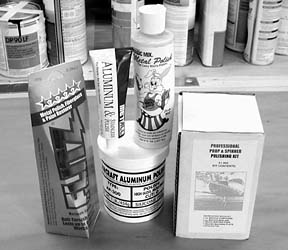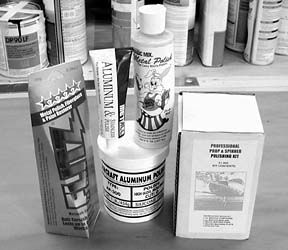
When its time to polish a prop spinner, we have no desire to commune with the metals inner oneness. Frankly, we prefer to smear some goop on the spinner, buff it off and get on with the flying.
Lots of products purport to be the best and easiest to use metal polishes. But most are made of similar materials and measuring much performance difference between them is a prayer. In a recent test of most of the metal polishes sold for props and spinners, our preference is for one of the old standbys, Flitz. Yet any of a dozen other polishes will also chase the tarnish off a spinner.
The important distinction is this: How oxidized is the metal and how often do you polish it? If you do it once a year and the aircraft lives outside, you’ll need a more aggressive polish than if you hit it once a month with a buff and some carnauba wax.
If youre a true connoisseur of the arcane art of metal polishing and the sort of shine snob who wrinkles your nose at the merest ripple in mirrored aluminum, you’ll want a couple of polishing products. In the world of serious metal polishing, only rank amateurs squirt little dabs of goop onto rags and have at it by hand. The pros use buffing machinery and, not surprisingly, some of the polishes sold for aircraft use are designed or at least better suited for machine polishing.
That doesnt mean they wont work with hand polishing but, as we learned, they clearly don’t work as we’ll or as fast. The apparent reason for this is that polishes intended for machine use are less aggressive than those meant for the dollop-and-rag crowd. You can use either method on a spinner, but given its small size and the need to polish in places where electricity or shop air isn’t available, hand polishing has an obvious allure.
All of the polishes work in basically the same way: A mild abrasive is mixed into a slurry of paste or liquid of some sort and the two work in concert to gently remove the oxidation and crud that make the typical polished spinner look tarnished after a few months of exposure.
Just whats in this stuff seems to be a trade secret among the manufacturers. Our queries to polish makers about ingredients were generally rebuffed, so to speak. In general, the abrasives are either fine grit aluminum oxide or material similar or identical to jewelers rouge. The binding agent may be a kerosene-based paste or an ammonia extract. Some polishes-Rolite, for example-are available in both liquid and paste form. Although you cant always tell the difference between a polished aluminum and a chromed spinner, the chrome type will need less aggressive buffing less frequently than a polished aluminum spinner will.
Chrome may be more resistant to the corrosive atmosphere around the typical airport but it may also need to be renewed periodically due to pitting, peeling or cracking.
How We Tested
We tried the various products on five spinners and one prop, all of which were polished aluminum. Three of the spinners were in relatively good shape to begin with, but two needed quite a bit of attention, obviously having been neglected for awhile.
Using clean, soft rags for each polish and/or DuPont Sontara aircraft wipes, we followed the manufacturers recommendations for each product. To compare performance, we polished strips on each spinner and compared the results visually.
Admitting that one mans mirror is anothers thumb smudge, our estimations of gloss are purely subjective. On the oxidized spinner, using hand polishing, we thought Flitz ($19.95 for a 5.3-ounce tube), Rolites Metal Polish ($14.20 for a 1-pound can) and a product called Magic Mix performed about equally, requiring equivalent effort to obtain a serviceable shine. (Magic Mix retails for $8.50 for an 8-ounce bottle.) Flitz would top our list, as it seemed to work a bit faster.
Another product from Rolite called AP-300 is sold at trade shows ($59 for a 1-pound tub) as a high-end metal polish. Its more suited to raising a deeper shine on an already well-polished surface than clearing off a layer of tarnish with hand polishing.
Other polishes we tried include Met-All Aluminum and Stainless Polish ($4.50 for a 2.5 ounce tube) MAAS ($21.50 for 1-pound can) and Mothers, an automotive metal polish that sells for $8.50 retail. All of these worked we’ll enough but not so we’ll that we would go out of our way to recommend them.
We conclude that given enough time, effort and clean rags, any of these polishes will get the job done eventually. The quality of the shine varies somewhat, however. For example, Flitz seems to produce a mirror-like surface very quickly while Rolites AP-300 works more slowly to produce a shine with more apparent depth, but its not effective on a highly tarnished surface. (Youd have to compare them side by side to notice any difference.)
Flitz seems to work faster because it has a more aggressive abrasive in a paste composed of an ammonia extract. (The liquid version of Flitz lacks the ammonia.) Both versions contain a carnauba type wax designed to seal the surface against further oxidation.
Rolites AP-300 also contains no ammonia, although the companys standard metal polish does. AP-300 is certified for use in the commercial aircraft industry which requires ammonia-free polishes to prevent embrittlement of steel parts. (Rolite says ammonia-induced embrittlement doesnt apply to aluminum.)
Machine Buffing
Of all the products we tried, only one-the Professional Prop and Spinner Polishing Kit from Tech Labs of Waterford, Wisconsin at $34 retail-is specially intended for machine use. In fact, the kit includes a mandrel for an electric or pneumatic drill and a soft foam and wool polishing pad, along with polishing paste and sealer.
Tech Labs Mike McClain, a veritable walking encyclopedia of polishing pointers, told us that this product is capable of restoring the rankest of tarnished spinners to a reflective luster in a matter of minutes. Its vaguely pinkish polishing compound contains jewelers rouge and, like Flitz, its relatively aggressive. Attacking a moderately dull spinner with the pad chucked in a drill, we worked over the entire surface in less than 30 minutes time, buffing the thing to an evenly shiny surface in shorter time than we could have done by hand. But there’s an art to managing the polishing wheel. Even though it works up a serious slurry that looks like its doing great things, its also easy to miss spots, yielding a splotchy shine at best. These can be remedied with more machine polishing or spot hand polishing. In any case, detail areas where the wheel wont reach have to be polished by hand.
Plan on a solid hour of work to bring back a really crummy spinner. Following the polishing, the surface is supposed to be sealed with a wax-type sealer included with the kit. That coating is allowed to dry and is then buffed with a soft cloth.
McClain told us that machine polishing creates a small amount of heat, which opens the metals crystalline surface structure, allowing the abrasive to achieve a much flatter surface. And the flatter the surface, the less the refraction and the better the shine, says McClain.
We asked if this kit is intended to take a spinner thats been stripped of paint to a finish polish and McClain said probably not. Painted spinners generally have mill rings and other imperfections that require more aggressive surface removal than polishing pastes are capable of doing, by design.
We agree with that assessment. When we stripped our spinner last year and attempted to polish it with a series of ever finer wet sanding, followed by paste polishes, we failed miserably. The thing looked like hell. Better to take the spinner to a metal polishing shop and pay $50 to $100 to have it done right (and quickly) on abrasive wheels intended for the purpose. The surface can then be kept up to snuff with paste polishes.
Trade Tricks
In researching this article, we heard about a few trips and tricks. Tech Labs McClain and others speak highly of machine polishing as the method of choice, even if all you have is a small electric or pneumatic drill to chuck the polishing pad.
Were told that the job will go more quickly and the results will be better. We agree, but its also more of a hassle if you don’t have electricity or air available. If the spinner is polished we’ll to begin with, keeping it shiny is not difficult if the work is done periodically. Second, although the people who make these polishing compounds like you to waste them prodigiously, using great mounds of the paste, they also admit that little dabs are better. Ideally, says McClain, use so little compound that when the appropriate shine is achieved, you wont even have to wipe off much excess. The instructions found on waxes and polishes generally recommend doing the work in the shade or out of direct sunlight. Thats good advice. Hot sun desiccates the polish and makes the abrasive slurry unworkable. And even when polishing in the shade or a hangar, a little moisture on the polishing cloth helps.
We like the Dupont Sontara wipes but our second choice for polishing is soft cotton cloth of the sort used for t-shirts, followed by terry cloth for buffing. Paper towels should be avoided for the final buffing stage and for glass cleaning because theyre mildly abrasive. Use soft cloth or the Micro Fiber products described on page 10. Some metal polishers recommend wax treatments to reduce oxidation while others say you’ll do as we’ll to polish more often rather than less. The recommendation for wax-something we didnt test-is ordinary carnauba wax applied over the spinner as soon as its polished.
Last, the flour trick. We heard about this from several sources in the polishing field. The idea is to use flour or corn starch as a final rubdown to absorb the last bits of polish and aluminum particles, thus improving the final results. Many owners seem to swear by this trick.
But Tech Labs Mike McClain, who did a tour polishing aluminum at Boeing, blanches at the thought. He says small bits of flour find their way into the metals crystalline surface structure where they absorb and retain moisture, eventually causing discoloration and corrosion. How about rinsing the flour out with a non-corrosive solvent? Not likely to remove the stuff, says McClain. We have no data to support flours efficacy in improving polishing results nor any direct experience in corrosion caused by using flour. you’ll have to make your own call.
Recommendations
As noted up front, all of these polishes seem to get the job done in one fashion or another. While we agree that polishes intended for use with machine buffing pads are more effective when used in that manner, we also think its impractical to carry these materials in the airplane, if thats your wont.
For hand polishing, our first choice remains a tube of Flitz and some Sontara wipes or soft cotton cloth. But thats not to say the other products wont polish a spinner. It just may take a bit longer. Valcos Magic Mix and Rolites standard metal polish did nearly as well.
If your spinner is badly tarnished from exposure to weather or neglect, the machine polishing kit from Tech Labs will bring it back for little time spent, then occasional treatment with Flitz or one of the other polishes will keep it in good shape.
Also With This Article
Click here to view the spinner polish checklist.
Click here to view “DuPont’s Synthetic Polishing Cloth.”.
Click here to view the contacts and addresses.





